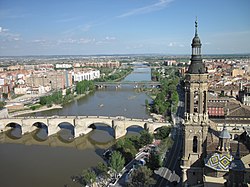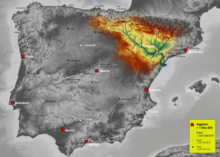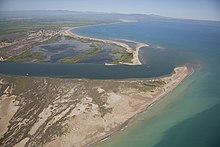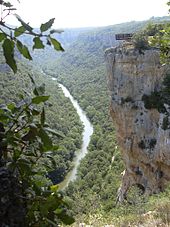Ebro
| Ebro Catalan:Ebre | |
|---|---|
 The Ebro River in Zaragoza | |
 The Ebro river basin | |
| Native name | |
| Location | |
| Country | Spain |
| Region | Cantabria,Castile and León,Basque Country (autonomous community),La Rioja,Navarre,Aragon,Catalonia,Valencian Community |
| Physical characteristics | |
| Source | |
| • location | Fontibre,Cantabria,Spain |
| • coordinates | 43°2′21″N4°24′11″W/ 43.03917°N 4.40306°W |
| • elevation | 1,980 m (6,500 ft) |
| Mouth | |
• location | Mediterranean Sea,Province of Tarragona,Catalonia,Spain |
• coordinates | 40°43′12″N0°51′47″E/ 40.72000°N 0.86306°E |
• elevation | 0 m (0 ft) |
| Length | 930 km (580 mi) |
| Basin size | 80,093 km2(30,924 sq mi) |
| Discharge | |
| • location | mouth |
| • average | 426 m3/s (15,000 cu ft/s) |
| Basin features | |
| River system | Ebro basin |
| Tributaries | |
| • left | Nela,Jerea,Bayas,Zadorra,Ega,Arga,Aragón,Gállego,Cinca,Segre |
| • right | Oca,Oja,Tirón,Najerilla,Iregua,Cidacos,Alhama,Jalón,Huerva,Martín,Guadalope,Matarranya |
 | |
TheEbro(Spanish and Basque[ˈeβɾo];Catalan:Ebre,Western:[ˈeβɾe],Eastern:[ˈeβɾə]) is a river of the north and northeast of theIberian Peninsula,inSpain.It rises inCantabriaand flows 930 kilometres (580 mi), almost entirely in aneast-southeastdirection. It flows into theMediterranean Sea,forming adeltain theTerres de l'Ebreregion, in southernCatalonia.In the Iberian peninsula, it ranks second in length after theTagusand second indischarge volume,anddrainage basin,after theDouro.It is the longest river entirely within Spain; the other two mentioned flow intoPortugal.It is also the second-longest river in the Mediterranean basin, after theNile.
The Ebro flows through many cities (Spanish:ciudades):[a]ReinosainCantabria;FríasandMiranda de EbroinCastile and León;Haro,Logroño,Calahorra,andAlfaroinLa Rioja;TudelainNavarre;Alagón,Utebo,andZaragozainAragon;andFlix,Móra d'Ebre,Benifallet,Tivenys,Xerta,Aldover,Tortosa,andAmpostain theprovince of Tarragona(Catalonia).
Geography
[edit]Upper part and tributaries
[edit]

The source of the river Ebro is in theCantabrian Mountains,inFontibre,Cantabria(Fontibreis from LatinFontes Iberis,i.e. 'source of the Ebro'). Close by is a largeartificial lake,Embalse del Ebro,created by its damming.
The upper Ebro rushes through rocky gorges inBurgos Province.Flowing roughly eastwards it passeslas conchas deHaroand begins forming a wider river valley amonglimestonerocks when it reachesLa RiojaandNavarre.Southern tributaries rise on the nearbywatershed,theSistema Ibérico,a mountain range among those of Spain's centre. North of the headwaters is theCantabrian mountain range(south ofBilbaoandSantander). Much of the total water volume of the Ebro comes from its northern tributaries, which drain about2⁄3of the southern slopes of thePyreneesmountains, which run along the border withFrance.
All of Andorra's drainage basin is in the Ebro, through theSegre.[1]
Climate
[edit]Downstream from Cantabria the climate in the Ebro basin – the valley being isolated from sea air masses by surrounding mountains – becomes Mediterranean/Atlantic influenced andcontinental.This implies summer/winter seasonal contrast and a rather dry climate. Summers of the Ebro Valley most often mirror those of asemiarid climate;some of them see more breaks of storms or showers, yet others are morearid,bringingdroughtsave where advanced irrigation is used.
The valleyflood plainsexperience annualrainfallbetween 300 and 600 mm (12–24 in), with maxima in fall and spring. It is often covered withchaparralvegetation. Summers are hot and winters are cold. The dry summer season has temperatures of more than 35 °C (95 °F), occasionally reaching over 40 °C (104 °F). In winter, the temperatures often drop below 0 °C (32 °F). In some areas the vegetation depends heavily on moisture produced by condensationfog.It is acontinental Mediterranean climatewith extreme temperatures. There are manyground frostson clear nights, and sporadicsnowfalls.
Soil and geology
[edit]The naturaltopsoilsacross the plains are, outside of historically well-forested zones, thin. The subsoil being close to the surface is organically poor and quick-draining: calcareous, pebbly, stony layers. These are in places salt-rich, seeing some saltwaterendorheiclagoons.
Karstgeological processes shaped the landscape of layers of solublecarbonate rockof extensive limestonebedrockformed in an ancient seabed.
Flow volume
[edit]The valley expands and the Ebro's flow then becomes slower as its water volume increases, flowing across Aragon. There, larger tributaries flowing from the central Pyrenees and the Iberian System discharge large amounts of water, especially in spring during the thawing season of the mountain snow.
Ecosystems
[edit]Thebiomesare diverse in these Mediterranean climate zones:Mediterranean forests, woodlands, and scrub.Hinterlands are particularly distinctive on account of extensivesclerophyllshrublands known asmaquis,or garrigues. The dominant species areQuercus coccifera(in drier areas) andQuercus ilex.These trees form monospecific communities or communities integrated withPinus,Mediterraneanbuckthorns,Myrtus,Chamaerops humilis,junipers,Pistacia,Rosmarinus,Thymus,and so on.
The hinterland climate becomes progressively more continental and drier, and therefore there is an end from extreme temperatures accompanied by slow-growing dwarf juniper species to unvegetated desert steppes as in "llanos de Belchite" or "Calanda desert".
The mountain vegetation is mostly coniferous forests that are drought-adapted, and hardier trees in the oak genus (Quercus), typically less tolerant, in the wetter highlands.
Halophiles(extremophilesas to salt) abound in zones of endorheic lagoons and their feeder creeks.Tamarix-covered, these include endemic species ofbryophytes,chenopodiaceas,plumbaginaceae,ruppiaceaes,Carex,lythraceaes, asteraceaes, and others. Their presence is related to the marine origin of the valley and the extensive marine deposits.
Just as it enters Catalonia, the valley narrows, and the river becomes constrained by mountain ranges, making wide bends. 3 massive dams have been built in this area:Mequinenza dam(Province of Zaragoza,1955),Riba-rojadam (1955), andFlixdam (1948), the latter two in theprovince of Tarragona.In the final section of its course the river bends southwards and flows through spectacular gorges. The calcareous cliffs and high, rocky hills of theSerra de Cardóalmost abut the river separating the Mediterranean coastal strip. After passing the gorges, the Ebro bends again eastwards nearTortosabefore discharging in adeltaon the Mediterranean Sea close toAmpostain the province ofTarragona.
The delta
[edit]

TheEbro Delta(Catalan:Delta de l'Ebre), in theTerres de l'Ebre('Ebro Lands') region,Catalonia,is at 340 km2(130 sq mi), or 20km² less,[2]one of the largestwetlandsof the western Mediterranean. Designated aRamsar site,[3]it has entirely grown on soils washed downriver—the historical rate of growth of the delta is demonstrated by the town ofAmposta.Recorded and thus confirmed as aseaportin theRoman Warm Periodin the 4th century, it is now well inland from the mouths.[2]The rounded form of the delta attests to the subsequent balance betweensedimentdeposition by the Ebro and removal of this material by waveerosion.[2]
The modern delta is in intensiveagriculturaluse for rice, fruit (in particular citrus), and vegetables.[2]The Ebro delta also has numerous beaches, marshes, andsalt pansthat provide habitat for over 300 species of birds.[2]
The Ebro delta was classified as a wetland area of international interest by Spain's Bureau Mar in 1962.[3]Since a phased-introduction law (1983 to 1986) Spain has designated 7,736 hectares (29.87 sq mi) as theEbro Delta Natural Park(Catalan:Parc Natural del Delta de l'Ebre) to protect its natural resources.[3][2]A network of canals and irrigation ditches dug by agricultural and conservation groups help to maintain the ecologic and economic resources of the delta.
Name
[edit]The Greeks called the riverἼβηρ(Ibēr),abir,ah'irand theRomanscalled it theHibēr,Ibēr,orIbērus flūmen,leading to its current name. TheIberian Peninsulaand theHibērīorIbērī(the people of the area) were named after the river.[4]It is not known with any certainty whether the Greeks used a local native name for the river. Nor is it known what the word "Ibēr"or"Hibēr"might mean. In modernBasquethe wordibarmeans 'valley' or 'watered meadow', whileibaimeans 'river', but there is no proof relating the etymology of the Ebro River with these Basque words. There are rivers in the Balkans calledIbar(Montenegro and Serbia) andEvros(Bulgaria and Greece).
History
[edit]
Inantiquity,the Ebro was used as the dividing line betweenRoman(north) andCarthaginian(south) expansions after theFirst Punic War(264–241 BC). When theRoman Republic,fearful ofHannibal's growing influence in the Iberian Peninsula, made the city ofSaguntum(considerably south of the Ebro) a protectorate of Rome, Hannibal viewed the treaty violation as an aggressive action by Rome and used the event as the catalyst to theSecond Punic War.
One of the earliestCistercianmonasteriesin Spain,Real Monasterio de Nuestra Señora de Rueda(lit. 'Royal'Monastery of Our Lady of the Wheel), is located on the banks of the Ebro inAragon.Established in 1202, the edifice survives intact. The monastery is strongly connected to the Ebro, since it used one of the first largewaterwheelsbuilt for the production of power in Spain. The monastery also diverted flow from the Ebro to create a circulating, hydrological central heating system for its buildings.
The Ebro in 1938 was the starting ground of one of the most famousRepublicanoffensives of theSpanish Civil War.Known as theBattle of the Ebro,the offensive ended in defeat for the Republican forces, although they enjoyed success in its first stages. They were not able to reach their objective ofGandesa.
Flow and floods
[edit]
The Ebro is the most important river in Spain in terms of length, 928 km (577 mi), and area of drainage basin, 85,550 km2(33,030 sq mi). However, the mean annual flow decreased by approximately 29 percent during the 20th century due to many causes: the construction of dams, the increasing demands forirrigationand the evaporation (higher than the rainfall, due to low rainfall, high sunshine and strong and dry winds) fromreservoirsin the river basins. This situation has a direct impact on the deltaic system at the mouth of the river because its hydrological dynamics are mainly controlled by the river discharge.
The decrease in river discharge has meant introduction of thesalt wedgefurther into the river. The mean annual river flow is approximately the critical flow which determines the formation and the break-up of the salt wedge. Thus, when the river discharge is between 300 and 400 m3/s (11,000 and 14,000 cu ft/s), the salt wedge can occupy the last 5 km (3 mi) of the estuary, but when the discharge is between 100 and 300 m3/s (3,500 and 10,600 cu ft/s), the salt wedge can advance up to 18 km (11 mi) from the mouth. For less than 100 m3/s (3,500 cu ft/s), the salt wedge quickly advances to its maximum extent, reaching 32 km (20 mi) from the mouth. In addition to decreased mean annual flow, the increased river regulation in the Ebro basin has produced daily and seasonal changes in the flow pattern.
With regards to the sediment load, several authors conclude that the sediment load was reduced by more than 99 percent during the last century. The drastic reduction insediment transportimplies a sediment deficit in the delta, which is causing the erosion of the coastline and lack of sediment replenishment. The unstable surface is due to weather changes andtidal surges.The river floods from time to time, although advance warning can now be given as a result of monitoring within the catchment area. The river flow inZaragozaduring floods, from the end of the 19th century is as follows:
- March 1888: 3,760 m3/s (132,800 cu ft/s)
- January 1891: 3,250 m3/s (114,800 cu ft/s)
- February 1892: 3,790 m3/s (133,800 cu ft/s)
- January 1895: 3,118 m3/s (110,100 cu ft/s)
- March 1930: 3,600 m3/s (127,100 cu ft/s)
- December 1930: 3,000 m3/s (105,900 cu ft/s)
- October 1937: 3,000 m3/s (105,900 cu ft/s)
- January 1941: 4,000 m3/s (141,300 cu ft/s)
- February 1952: 3,260 m3/s (115,100 cu ft/s)
- January 1961: 4,130 m3/s (145,800 cu ft/s)
- November 1966: 3,154 m3/s (111,400 cu ft/s)
- January 1981: 2,940 m3/s (103,800 cu ft/s)
- February 2003: 2,988 m3/s (105,500 cu ft/s)
- March 2003: 2,220 m3/s (78,400 cu ft/s)
- April 2007: 2,282 m3/s (80,600 cu ft/s)
The Ebro poured 1,874 millioncubic metres(1,519,000acre-feet) into the delta from 27 March 2007 to 11 April 2007, with an average of 117 million cubic metres (95,000 acre-feet) per day.
Ecology
[edit]Academics and local government have criticised ecological impacts of:
- dams
- pollution from populations
- factories
- agricultural dumping
- invasive speciesaffecting the originalecosystem;the introduced species have rapidly caused theextinctionof numerous indigenous species
In past times numerouslagoons,endorheicsaltwaterponds,and freshwaterswampsandmarsheswere drained, dried or filled. Almost entireriparian forestswere cleared for crops or forpulpwoodforest plantations. Due to these changes numerous plant and animal species have disappeared. Due to dams and hydraulic canalization, the dynamics of the river have been altered and newscroll-bars,newoxbow lakes,and new abandonedmeanderswill not now be created. Over a period of time, many of these phenomena tend to dry out or fill in with sediments. Some small representatives of these river dynamics andwetlandsare protected.
The Ebro Delta Natural Park, covering 7,802 hectares (19,280 acres), was finalised in 1986 and is of international importance for 8 of its plant species and 69 of its vertebrate fauna. It has some 95 breeding species of birds, is also very important for a wide range of overwintering species, and serves as an essential stopover point for large numbers ofmigratorybirds. The Ebro delta has the world's largest colony ofAudouin's gulls.In 2006 it held a record number of more than 15,000 pairs, its highest to date.
The introduction of American crayfishProcambarus clarkiihas resulted in economic losses, introduced elsewhere for cultivation, its success is attributable to its ability to colonise disturbed habitats that would deter the edibleiberian crayfish.The semiaquatic rodentMyocastor coypusis beginning to expand in some northwest tributaries of the head damaging crops and protected national parks in theBasque Country.Fish caught in all lower reaches of the Ebro are high inmercuryand theEuropean Unionprohibits their sale, notably the hugeWels catfish.
Thezebra mussel,aninvasive species,is expanding upstream in the Ebro's waters. Due to its rapid rate of reproduction, the species adversely affects the port's underwater machinery as well as that of dams and hydroelectric plants, in addition to competing with native species. Following the introduction of Wels catfish, many fish species' numbers are in clear and rapid decline. Since the Wels catfish's introduction in theMequinenza reservoirin 1974, it has spread to other parts of the Ebro and its tributaries, especially theSegre.Some endemics species of iberianbarbels,genusBarbusin theCyprinidae,have declined drastically, having once been abundant, especially in the Ebro. Competition and predation by Wels catfish caused its complete disappearance in the middle channel Ebro around 1990. Barbel species from mountain stream tributaries of the Ebro that Wels catfish have not colonized were not affected. The ecology of the river also now has the problem of a major increase in aquatic vegetation, seaweed and algae.
See also
[edit]Notes and citations
[edit]Explanatory footnotes
[edit]- ^City in Spain is much more liberally applied thancity status in the United Kingdom,France, Germany and Italy.
Citations
[edit]- ^"Andorra".Food and Agriculture Organization.Archivedfrom the original on 14 March 2022.Retrieved14 March2022.
Situated in a single drainage basin, Andorra's main stream, the Riu Valira (also known as Balira), only about 52 km long, has two distinct branches. One of these, the Valira del Norte (24 km), and its principal tributary, the Arinsal River, drain western Andorra. The Valira del Orien (28 km) drains the eastern part and has a tributary, the Madriu. The two branches unite in southwest Andorra to form the Gran Valira which leaves the country to join the Segre River 11 km south of the border in northeastern Spain. The Segre is a tributary of the Ebro; thus, all of Andorra's drainage is Mediterranean.
- ^abcdef"Ebro River Delta, Northeastern Spain".NASA Earth Observatory.Archived fromthe originalon 30 September 2006.Retrieved24 May2006.
- ^abcEbro Delta Natural ParkArchived15 January 2008 at theWayback Machine
- ^Westrem, Scott D.The Hereford Map: A Transcription and Translation of the Legends With Commentary,page 328. Brepols, 2001.
External links
[edit]- .Encyclopædia Britannica.Vol. 8 (11th ed.). 1911.
- The River Ebro and Delta
- The Ebro Delta from Space
- The Ebro Delta at Google Maps
- Photo gallery of the Ebro Delta and surrounding area: birds, landscapes and people
- The Trinidad Salt Pans within the Ebro River Delta Nature Reserve
- Awarded "EDEN – European Destinations of Excellence" non traditional tourist destination 2009
- "Ebro"in theColumbia Encyclopedia
